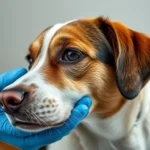
Introduction
Ehrlichiosis in dogs is a serious tick-borne disease caused by bacteria belonging to the genus Ehrlichia. It’s crucial for dog owners to understand this disease, as it can lead to significant health issues if not detected and treated promptly. This article aims to provide a thorough understanding of ehrlichiosis in dogs, covering its symptoms, prevention strategies, and treatment options. With expert opinions and real-life experiences included, we hope to empower dog owners with the knowledge to safeguard their pets.
What is Ehrlichiosis?
Ehrlichiosis is an infectious disease primarily caused by the Ehrlichia bacteria, which infect white blood cells in dogs. The most common types of Ehrlichia that affect canines include Ehrlichia canis and Ehrlichia ewingii.
- Ehrlichia canis is most frequently associated with the brown dog tick (Rhipicephalus sanguineus) and is prevalent in warmer climates.
- Ehrlichia ewingii typically affects dogs more commonly found in the southern and central United States.
The geographic prevalence of ehrlichiosis in dogs varies, and certain risk factors can increase exposure, including living in areas with high tick populations, spending time outdoors, and the seasonality of tick activity, which peaks during warmer months.
How Do Dogs Get Ehrlichiosis?
Dogs primarily contract ehrlichiosis through the bite of an infected tick. The most notorious tick responsible for spreading this disease is the brown dog tick. Understanding the transmission route is crucial for effective prevention.
Factors Increasing Exposure to Ticks
- Environment: Dogs that spend time in grassy, wooded, or bushy areas are more susceptible to tick bites.
- Seasonality: Spring and summer are peak seasons for tick activity, making dogs more vulnerable during these times.
By being aware of these factors, dog owners can take proactive measures to protect their pets from tick bites and the diseases they carry.
Symptoms of Ehrlichiosis in Dogs
Recognizing the symptoms of ehrlichiosis in dogs is vital for early intervention. The disease progresses through phases, each with distinct signs.
Acute Phase Symptoms
In the acute phase, which occurs shortly after infection, dogs may exhibit:
- Fever: A sudden rise in body temperature is common.
- Lethargy: A noticeable decrease in energy levels and enthusiasm.
- Loss of Appetite: Affected dogs may show little interest in food.
- Nosebleeds: This symptom can be alarming and should prompt immediate veterinary attention.
Subclinical Phase Symptoms
During the subclinical phase, dogs may appear healthy, displaying no visible symptoms. However, this does not mean the disease is inactive, making regular monitoring essential.
Chronic Phase Symptoms
If left untreated, ehrlichiosis in dogs can progress to a chronic phase characterized by:
- Weight Loss: Gradual or rapid weight loss can indicate severe health issues.
- Anemia: A reduction in red blood cells, leading to pale gums and weakness.
- Joint Pain: Dogs may show signs of discomfort when moving or may become less active.
- Behavioral Changes: Changes in behavior, such as increased irritability or withdrawal, can occur.
Dog owners should observe their pets closely for these signs, particularly if they live in tick-prone areas.
Diagnosis of Ehrlichiosis
Diagnosing ehrlichiosis in dogs requires veterinary expertise. Several diagnostic tests can help confirm the presence of the disease.
Overview of Diagnostic Tests
- Blood Tests: Serological tests can detect antibodies to Ehrlichia bacteria, while PCR testing can identify the genetic material of the bacteria itself.
Importance of Consulting a Veterinarian
A veterinarian’s role is crucial in diagnosing ehrlichiosis in dogs accurately. Various other conditions may present similar symptoms, necessitating differential diagnoses to rule out other potential illnesses.
Treatment Options for Ehrlichiosis
Once diagnosed, treatment for ehrlichiosis in dogs typically involves a combination of antibiotic therapy and supportive care.
Antibiotic Therapy
- Common Antibiotics Used: Doxycycline is the most frequently prescribed antibiotic for treating Ehrlichia infections. Treatment duration typically lasts for several weeks, depending on the severity of the disease.
Supportive Care
In addition to antibiotics, supportive care is vital for recovery:
- Hydration and Nutrition: Ensuring the dog stays hydrated and receives proper nutrition is essential for recovery.
- Pain Management Strategies: Pain relief may be necessary if the dog experiences joint pain or discomfort.
Monitoring Recovery and Potential Complications
Regular follow-ups with the veterinarian are critical to monitor recovery and watch for potential complications or relapse of symptoms.
When to Seek Emergency Care
If symptoms worsen or new symptoms arise, such as severe lethargy, difficulty breathing, or uncontrolled bleeding, immediate veterinary care is necessary.
Prevention of Ehrlichiosis
Preventing ehrlichiosis in dogs is far better than treatment. Here are several effective strategies:
Importance of Regular Tick Prevention
Regular tick prevention should be a priority for all dog owners, particularly in areas where ticks are prevalent.
Recommended Tick Prevention Products
- Collars: Specially designed tick collars can provide long-lasting protection.
- Topical Treatments: These are applied to the skin and can repel ticks for a specified period.
- Oral Medications: Some oral medications work systemically to prevent tick infestations.
Environmental Control Measures
Maintaining a tick-free environment is also crucial:
- Yard Maintenance: Regularly mowing the lawn and keeping bushes trimmed can deter ticks.
- Avoiding Tick-Infested Areas: Steering clear of known tick habitats during walks or outdoor play can reduce exposure.
Regular Vet Check-ups and Tick Checks
Routine veterinary check-ups and performing tick checks after outdoor activities can help catch any infestations early.
FAQs About Ehrlichiosis in Dogs
Can humans get ehrlichiosis from dogs?
No, Ehrlichia bacteria are transmitted through tick bites and do not spread directly from dogs to humans. However, humans can contract ehrlichiosis from infected ticks.
What should I do if I find a tick on my dog?
Remove the tick promptly using fine-tipped tweezers, grasping it as close to the skin’s surface as possible. Clean the bite area with rubbing alcohol and monitor for any signs of infection or illness.
How can I tell if my dog is recovering from ehrlichiosis?
Signs of recovery may include increased energy, a return of appetite, and improved overall demeanor. Follow-up visits to the veterinarian can provide definitive answers regarding recovery.
Conclusion
Awareness and education about ehrlichiosis in dogs are vital for all dog owners. Understanding the symptoms, prevention strategies, and treatment options can significantly impact your dog’s health and well-being. By maintaining preventative measures and seeking veterinary advice when needed, you can help ensure a healthy lifestyle for your beloved pet. Remember, early detection and treatment are key to overcoming this tick-borne disease.









